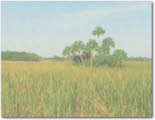Project Personnel: Jeane-Claude Thomas, Dan Sechrist, Greg Desmond, Susan Price, Robert Glover, George Lemeshewsky, Nancy Rybicki
![]()

Principal Investigator: John W. Jones
For more information, please see the Tides and Inflows in the Mangrove Ecotone (TIME) Model Development Project Webpage.
Multiple south Florida stakeholders from government, private industry,
environmental, and citizen sectors have begun collaborating in an effort
to return the Florida Everglades system to its natural state. Research
into the measurement and modeling of water movement and other hydrologic
processes have therefore been identified as a primary science need in support
of Everglades restoration. In order to accurately simulate surface water
hydrology in South Florida, the variation in vegetation cover and the role
vegetation plays in removal of surface water, resistance to surface water
flow, and water quality, is necessary. The objective of this research is
to develop and apply innovative remote sensing and geographic information
system techniques to map the distribution of vegetation and related hydrologic
variables such as evaporation through space and over time. This work will
provide insights regarding the role south Florida vegetation plays in the
redistribution of rainfall and surface flow inputs as well as the cycling
of nutrients and other materials in the Everglades waters. It will contribute
to our understanding of hydrology at large scales. Finally, it will lay
the foundation for monitoring restoration impacts on Everglades flora.
These benefits are vital in building the understanding required to properly
monitor, simulate, and manage the unique Everglades wetland resource.
Summary
The objective of this research is
to develop and apply innovative remote sensing and geographic information
system techniques to map the distribution of vegetation and related hydrologic
variables such as evaporation through space and over time.
Proposals
Project Summaries
Work Plans
Data
Metadata
Publications
Abstracts:
Project Bibliography
Map:
Fact Sheet:
Paper:
This page is: http://sofia.usgs.gov/projects/remote_sens/index.html
Comments and suggestions? Contact: Heather Henkel - Webmaster
Last updated: 27 August, 2004 @ 05:38 PM (HSH)
